History of Sex in Cinema
Movie Title | Brief Scene Description | Example |
| Eadweard Muybridge's Primitive Motion Studies (from 1884-1887) - The Human Figure in Motion - Descending Stairs and Turning Around | Muybridge's test footage included cinematic glimpses of naked men and women in motion, such as this female walking up and down stairs | 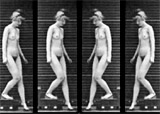 |
| Le Coucher de la Marie (1896, Fr.) (aka Bedtime for the Bride) | "Blue movie" pornographer Eugene Pirou pioneered the risque film, when reportedly, he produced this film (and other similar "smoking concert" or stag party films) in which Louise Willy performed the first striptease onscreen; the short film was directed by Léar (real name Albert Kirchner) | |
| This short nickelodeon kinetoscope/film of a gyrating belly dancer named Fatima (well-known for her dancing shows at the Columbia World's Exhibition in 1893) became the first film in which a scene was censored - for her gyrating and moving pelvis; it was covered up by what appeared to be a white picket fence (a grid-like pattern of white lines); there were numerous risque films that featured exotic dancers | 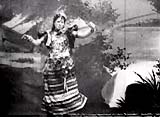 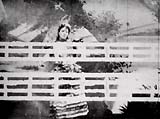 | |
| The very first kiss on film was between a Victorian couple seen in this Edison kinetoscope in a filmed scene enacted from the Broadway stage play The Widow Jones - the titillating short 20-second film loop, with a close-up of a nuzzling couple followed by a short peck on the lips ("the mysteries of the kiss revealed"), was denounced as shocking and pornographic to early moviegoers and caused the Roman Catholic Church to call for censorship and moral reform - because kissing in public at the time could lead to prosecution | 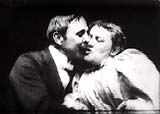 | |
| Après Le Bal (1897, Fr.) (After the Ball, Bath) | Pioneering film-maker Georges Melies directed this film, with one of the earliest nude scenes in film history - it was a short black and white silent film | |
| Annabelle (Whitford) Moore's Dance Routines (mid 1890s) | Many of the earliest nickelodeon films featured the dancing of vaudeville performer Annabelle Whitford (known as Peerless Annabelle), whose routines were filmed at Edison's studio in NJ - Annabelle Butterfly Dance (1894), Annabelle Sun Dance (1894), Annabelle Serpentine Dance (1895), Serpentine Dance by Annabelle (1896), Annabelle in Flag Dance (1896), Skirt Dance by Annabelle (1896), Tambourine Dance by Annabelle (1896), Sun Dance - Annabelle (1897), etc.; male audiences were enthralled watching these early depictions of a clothed female dancer (sometimes color-tinted) on a Kinetoscope - an early peep-show device for projecting short films | 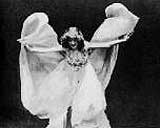 |
| The Birth of the Pearl (1901) | Proprietors of the arcade parlors and nickelodeons with hand-cranked kinetoscopes, designed to provide cheap entertainment for poor, lower-class immigrants in the cities, realized that sex (or erotica) sold - as in this short provocative American Mutoscope & Biograph film about the 'birth of a pearl' in an art tableau; when the curtains were drawn to the side by two clothed chorus girls, a large oyster or clam shell was revealed in front of a painted backdrop of the ocean; as the shell opened, a sleeping or slumbering long-haired young model (wearing a flesh-colored body stocking) was curled up, but then slowly awakened from slumber and stood up | 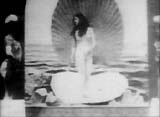 |
| From Show Girl to Burlesque Queen (1903) | This titillating short (one-minute in length) film from American Mutoscope & Biograph was designed to stimulate its audience, with the view of a woman in her dressing room mischievously undressing and smiling at the camera - but after removing clothing and standing in a long white undergarment (and slipping the strap of her garment off one shoulder), she ducked behind a screen to her right, where she continued to undress and furtively reach for other clothes; she then appeared costumed in another outfit | 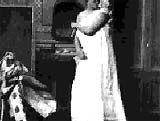 |
| Peeping Tom in the Dressing Room (1905) | This voyeuristic short was sexually enticing to early male audiences; after being caught 'peeping' through a keyhole while spying on a buxom female as she dressed, the humiliated man was brought into the dressing room, where chorus girls beat him with powder puffs; a similar earlier title was Biograph's Peeping Tom (1897) | 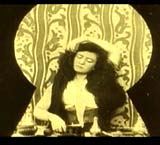 Peeping Tom (1897) |
| Traffic in Souls (1913) | Carl Laemmle's newly-formed Independent Motion Picture Company's (IMP) first feature-length film release - the first American feature-length sex film - was the six-reel melodrama (and faux documentary) Traffic in Souls (1913) (aka While New York Sleeps). It was a "photo-drama" expose of white slavery (entrapment of young women into prostitution) at the turn of the century in NYC, although the film exploitatively promised steamy sex in its advertisements; this was one of the first films to understand that 'sex sells,' although its producers worried that a 'feature-length' film on any subject wouldn't be successful; it was the most expensive feature film of its time at $57,000, although its record earnings were $450,000 | 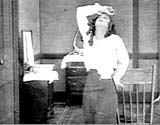 |
| Damaged Goods (1914) also Damaged Goods (1919, UK) | This early, dramatic sex-hygiene (venereal disease) educational film (now presumed lost) was typical of an early exploitation film with sensational content told with an educational slant; it told about how young lawyer George Dupont (Richard Bennett) contracted syphilis from a prostitute (Adrienne Morrison, Mrs. Bennett in real-life), and passed on the disease to his fiancee-wife (Senator Locke's daughter Henriette (Olive Templeton)) and baby (against Dr. Clifford's (Louis Bennison) advice); by film's end, Dupont committed suicide by drowning himself (although in the re-release, the suicide was toned down); it was a smash-hit at the box-office when re-released in 1915 by the Mutual Film Corporation, with $2 million, and caused a wave of similar films for the rest of the decade; a silent British version of the film was directed by Alexander Butler in 1919; other films in this sub-genre included The Spreading Evil (1918), The Scarlet Trail (1918), Open Your Eyes (1919), The Solitary Sin (1919), and Wild Oats (1919) | |
| | D.W. Griffith's Civil War epic was controversial for many reasons, one of which was its racist and "vicious" portrayal of blacks and its proclamation of miscegenation, according to the NAACP; for that reason, it was the subject of bans for inciting "race hatred and race riots"; for example, in one long suspenseful scene, an emancipated former house servant/slave - an inflamed, lusty Negro "renegade" named Gus (Walter Long) chased after young Flora Cameron (Mae Marsh); although he reassured her: "Wait, missie, I won't hurt yeh", she fell from a cliff after repeatedly threatening him -- "Stay away or I'll jump"; the scene has often been misinterpreted as a rape scene, although it wasn't; however, it could be interpreted that her threatening symbolized the emasculation and 'rape' of whites in the South by a rampant black population suddenly emancipated - and destructive of the racial order; in another controversial scene, lecherous mulatto leader Silas Lynch (George Siegmann, a white actor dressed as black and acting monstrously) attacked Elsie Stoneman (Lillian Gish) and attempted to force marriage upon her | 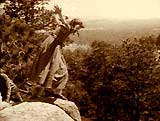 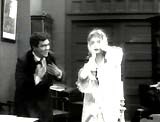 |
| A Fool There Was (1915) | The full-bosomed Theda Bara, dubbed the "Vamp," was the screen's first femme fatale, predatory vamp (luring men to ruin and destruction) and first movie sex goddess; she was a Hollywood creation who mixed ruthlessness and dark erotic sexiness into her numerous roles - she would often appear in risque transparent costumes; Bara was first introduced as an evil temptress in this film with her character name: Vampire, and her most-famous line of all: "Kiss me, my Fool!"; the Vamp character was repeated in Bara's melodramatic The Devil's Daughter (1915) in the role of La Gioconda, and also in The Vixen (1916) | 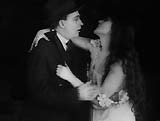 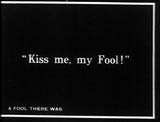 |
| A Free Ride (1915) | This film was reportedly the earliest-known silent stag ('men only') or pornographic film; because these kinds of films (with increasingly explicit amounts of nudity and sexuality) were completely illegal, they were shown in all-male locations, clubs, etc., not in mainstream theaters | 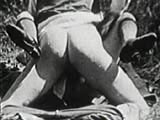 |
| Hypocrites (1915) | This was Paramount's 4-reel silent film from female director Lois Weber - the most important and prolific of all American women directors of the silent era; it was considered a shocking and controversial film that was held up for many months because of its full nudity - a ghostly figure of the Naked Truth, literally portrayed by a nude woman (Margaret Edwards) who revealed hypocritical desires for money, sex, and power | 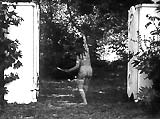 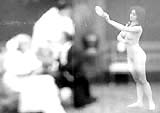 |
| Inspiration (1915) (aka The Perfect Model) | Audrey Munson (a real-life model for numerous Beaux-Arts sculptors) first appeared artistically nude as a sculptor's model (in her first of four silent films) to recreate classic artistic (nude) paintings in George Foster Platt's controversial film from the Mutual Film Corporation - telling the story of her own life; it has been claimed that this was the first known film in which a leading actress stripped down to be naked, making her the first nude film star |  |
| Behind the Screen (1916) | In this two-reeler for Mutual, Chaplin portrayed a hired worker named David at a film studio - in the film's infamous 'gay' scene, he kissed a young girl (Edna Purviance) who was dressed in masculine clothing (as a masquerading way to find work), thereby upsetting his brutish and burly foreman Goliath (Eric Campbell) who believed they were homosexual and teased them mercilessly by acting 'prissy' to mock them | 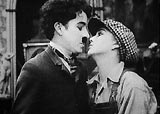 |
| Daughter of the Gods (1916) | Australian-born swimming and diving champ Annette Kellermann (the "Esther Williams of the silent era" who was called "the world's most perfectly-formed woman" and billed as "the Diving Venus") had already gained attention for advocating the scandalous-at-the-time one-piece bathing suit; she caused a further stir when she was seen naked with her flowing hair under a waterfall - she was the first major female star to appear nude on screen; this controversial film, Kellermann's second feature film, was also the most expensive film of its decade at $1 million; earlier films included Siren of the Sea (1911), The Mermaid (1911), and her first feature film Neptune's Daughter (1914) | 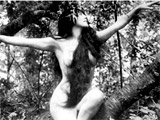 |
| Intolerance (1916) | D.W. Griffith's epic featured bare-breasted, lightly-draped women ("virgins of the sacred fires of life") in love temples, in the tinted Babylonian sequences |  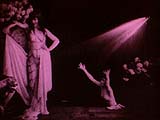 |
| Purity (1916) | After her appearance a year earlier in Inspiration (1915), sculptor's model Audrey Munson also appeared nude in another silent film, Rea Burger's 7-reel Purity (1916), in a dual role, as a spirit figure and as an artist's nude model named Purity/Virtue | 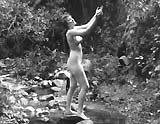 |
| The Vixen (1916) | In this lost film, Theda Bara took the role of spoiled, deceiving nymphomaniac "vixen" Elsie Drummond, who wooed Wall Street businessman Martin Stevens (A. H. Van Buren) away from his interest in her sweet sister Helen (Mary G. Martin); she continued to seek after rich men, eventually marrying young statesman Knowles Murray (Herbert Heyes) (again stolen from Helen) - but still willing to be unfaithful with Stevens who had since regained his fortune | |
| Cleopatra (1917) | This elaborately-produced film (now presumed lost) from the Fox Film Corporation was one of vamp Theda Bara's biggest hits - as the historical Queen of Egypt Cleopatra -- noted for her risque and bare-breasted costuming; she was seen nearly nude with the contours of her breasts held by two curving gold asps; and she wore a gown with spidery embroidery over her crotch |  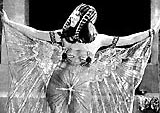 |
| Mack Sennett's "Bathing Beauties" | Comedy pioneer and "King of Comedy" Mack Sennett popularized his sexually-appealing "bathing beauties" starlets (usually uncredited swimsuit models, although some became famous leading ladies, such as Juanita Hansen, Phyllis Haver, Gloria Swanson and the original bathing beauty Mabel Normand) by having them appear bare-legged in his cheaply-made popular slapstick comedies; although he was accused of exploiting their bodies by the Temperance Movement, they remained popular | 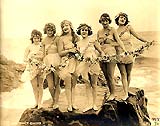 |
| Isle of Love (1918) (aka An Adventuress (1920)) | Young starlet Virginia Rapp (with the screen name of Rappe), who was later portrayed as the victim in the rape/murder case/scandal involving silent film comedian Roscoe "Fatty" Arbuckle on Labor Day 1921, appeared in this film (she ultimately appeared in small roles in about 10 films during her short career); she had developed a trampish reputation as one who would frequently strip and sometimes modeled in the nude; her biographical information claimed multiple abortions, venereal disease, dabbling in prostitution, and an out-of-wedlock child raised by foster care; in any event, she laid the blame on Arbuckle before her death four days later of a ruptured bladder | 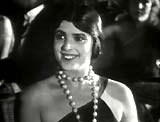 |
| Tarzan of the Apes (1918) | In this ten-reel silent film that was the first screen version of Edgar Rice Burrough's jungle character, Tarzan at ten years old (Gordon Griffith as younger ape-boy Tarzan, Elmo Lincoln as adult) was almost nude for much of the first half of the film; the breasts and buttocks of African natives were also briefly shown | 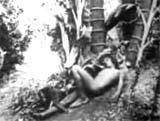 |
| Anders als die Andern (1919, Germ.) (aka Different From the Others) | This silent film (only half of it survives) by director Richard Oswald was reportedly the first representation of male homosexuality ("the third sex") in a feature-length film, and the first screen depiction of a gay bar (with gay males and butch females); it was also notable for sympathetically portraying homosexuality; the two ill-fated lovers were prominent pianist Paul Korner (Conrad Veidt) and his young music student, Kurt (Fritz Schulz); the film had a tragic ending (suicide for Korner) due to the effects of blackmail (threats of exposure), jail time for violating anti-homosexuality statutes, and the social stigma of being outed; the film was banned by the Nazis and all prints were ordered destroyed, although one incomplete print surfaced in the Ukraine; the film's themes were repeated in Victim (1961, UK), with Dirk Bogarde. | 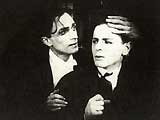 |
| Back to God's Country (1919, Can.) | This exploitative melodrama, by actress/writer/producer Nell Shipman (and directed by David Hartford), was probably the most successful Canadian silent feature film; it featured the first full-frontal female nudity of a "star" in the history of cinema (in a nude-swimming scene, although she was covered by a flesh-covered leotard of some kind); it was taglined: "Is the Nude Rude?" - and due to its lurid advertising, it became the highest-grossing Canadian film made during the silent era | 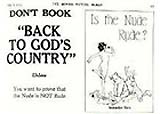 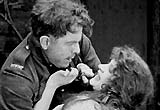 |
| Male and Female (1919) | A production by Cecil B. DeMille, this film starred Gloria Swanson as snobby, pampered socialite Lady Mary Lasenby, seen in a half-naked risque bathing scene, and in a dreamy "King of Babylon" flashback as a Christian slave girl in a leopard skin - including her descent into a Babylonian lion's den wearing a dress of pearls and feathers; these kinds of scenes were typical of DeMille's brash and extravagant Biblical epics - an excuse to combine religion with sex | |
